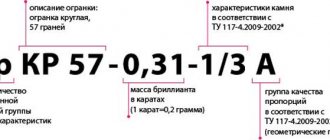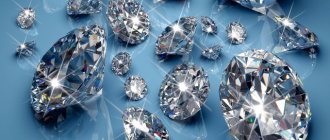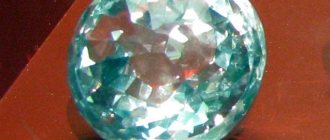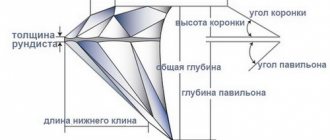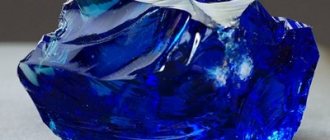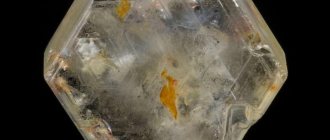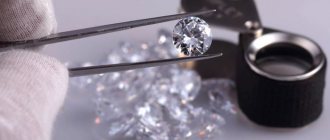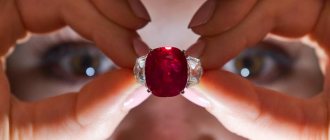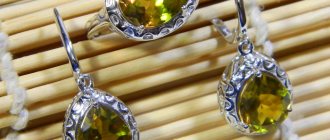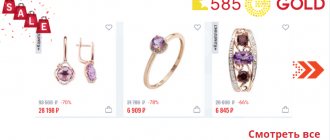Many people associate the diamond stone with luxury and unique radiance, and all because this gift of nature is closely related to diamonds (these stones are made precisely from diamonds). The unique diamond stone appeared on Earth several million years ago. The diamond stone was formed from the cooled melt of silicate in the mantle of the earth's crust, located at a depth of 150 kilometers. Thanks to explosive processes occurring inside the earth's crust, the silicate melt managed to break through to the surface of the planet and turn into the so-called kimberlite pipes, which consist of 15% diamond. What color is a diamond in nature?
Diamonds in the rough
Color scale.
The color of a diamond is graded based on whether the stone has yellow undertones and how visible they are. The GIA classifies diamond colors into groups that contain individual grades.
Here are the color groups according to this scale (the varieties each group contains are indicated in parentheses): colorless (grades D, E and F), almost colorless (G, H, I, J), faint yellow (K, L, M) , very light yellow (N, O, P, Q, R), light yellow (S to Z).
Diamonds that are very intense in color are considered unusually colored and are not graded on this scale. Sometimes the color grade of such stones is designated as Z+.
How does color affect the appearance of a diamond?
Diamond color is graded on a letter scale, with the highest grade being D, which indicates a completely colorless diamond.
The lower the grade, the more colored the stone appears. Diamonds graded K or below have a slight yellow tint that becomes more noticeable the lower you go on the color scale.
How is color formed?
To understand what the color of a diamond can be, you should consider the composition of this stone. The diamond mineral is almost 99% pure carbon, but 1% of the stone’s composition includes other elements: chromium, manganese, boron, silicon, etc. It is the impurities that determine the shade of the diamond. In nature, the bulk of the volume of mined diamonds comes from colored stones, while colorless diamonds are considered quite rare.
The color of diamonds is characterized by unevenness, however, every stone created by nature has this feature. There are also diamonds that combine several colors at once. As for the color intensity of the stone, diamonds are characterized by pale tones.
Considering what the colors of a diamond are, it does not hurt to divide all diamonds based on their scope of application. What types of diamonds are there?
- Jewelry: Stones that are suitable for use in diamond production account for only 15% of total diamond production. Minerals that can be cut into diamonds must have perfect clarity. The most common shades of such stones are yellow, brown and smoky. Due to their rarity, purple, pink and green diamonds are highly prized.
- Technical: the bulk of diamond production comes from stones that are used in other areas of production. Industrial diamonds are characterized by complete opacity. The most popular varieties of such stones are carbido, ballas, and carbonado.
Diamond became one of the most valuable stones after its physicochemical properties were studied in detail, and this happened around the sixteenth century. Since then, diamonds have become associated with luxury and high material status. Today, jewelry stores, various repair products, cosmetics, and even computer games are named after diamonds. An example of this is the game Chameleon Diamonds, a 3D version of the popular game Zuma. The virtual entertainment consists of hundreds of puzzles in which you can accumulate and explode shining diamonds according to the rules of the game.
Diamonds are processed diamonds
In nature, there are other minerals that are very reminiscent of diamond in appearance - these are rock crystal, white topaz, leucosapphire, etc. Often, fake diamonds are made from these stones, for example, from crystal.
Definition of purity.
A diamond's clarity grade is assigned by a trained gemologist who examines the stone under a microscope. Unless you are a professional jeweler and use grading equipment, it is very difficult to determine the exact clarity grade.
However, you can guess the approximate grade of the stone by looking at it with tenfold magnification. Here are some tips that can help you determine the clarity of a diamond:
If you do not see any imperfections (lines, dark spots or dots) in the stone when looking at it under 10x magnification, then the diamond most likely falls into the FL/IF/VVS1/VVS2 clarity range.
If the diamond has no noticeable flaws, but you can see some inclusions under a loupe or microscope, then the stone is likely VS1, VS2 or SI1 clarity.
Some of these stones may sometimes have imperfections that are visible to the naked eye, but such inclusions will nonetheless be difficult to detect.
Some diamonds contain inclusions that are visible to the naked eye, but they are relatively small and located around the edges of the stone.
Such diamonds will likely be classified as SI2 - they are not clear enough to be considered SI1, but they are not included as explicitly as stones in the I range.
Finally, diamonds that have relatively large flaws that are easily visible to the naked eye would most likely be classified as I1/I2/I3 grades.
How is a diamond's clarity assessed?
Diamond, like any natural mineral, is not without flaws. Craftsmen do everything in their power to bring diamonds closer to ideal, but there are indicators that the human hand cannot influence.
What does diamond clarity mean?
The term "clarity" describes the number and nature of inclusions or surface blemishes present in the stone. The most characteristic inclusions for diamonds are brown particles of spinel, red garnet, dark inclusions of ilmenite or magnetite, and green malacolite. As a result, the degree of purity (the term “clarity” is also used) depends on the percentage of inclusions, their dimensions, as well as on the zone of the cut stone in which they are located. To evaluate this indicator, a magnifying glass with tenfold magnification is used.
Also read: Jewelry with Chrysolite
Diamond Clarity
A diamond's clarity rating affects the depth of penetration as well as the degree of refraction of light. The lower the inclusion content, the brighter the diamond's edges will shine. A nugget devoid of internal inclusions is considered ideal. The craftsman eliminates external flaws by cutting and polishing. However, the presence of foreign particles indicates the naturalness of the diamond.
GIA grading scale
The generally accepted GIA classification distinguishes 12 groups that evaluate the clarity of a diamond.
Stone purity table
GIA Diamond Clarity Groups
According to this classification:
- FL is a gem of ideal quality.
- IF – inclusions are not noticeable under a magnifying glass, minor surface flaws can be easily eliminated by re-processing.
- VVS1 – the presence of microscopic inclusions, visible only when viewed through the pavilion, as well as the presence of shallow inclusions, which can be removed after the next polishing.
- VVS2 – microscopic inclusions are difficult to see through the platform.
- VS1 – the presence of inclusions in the form of clouds or feathers that are difficult to see under a magnifying glass.
- VS2 – inclusions in the form of clouds and feathers are easier to see.
- SI1 – small inclusions that can be easily viewed under a magnifying glass.
- SI2 – small inclusions, easily visible under a magnifying glass.
- SI3 – small inclusions visible to the naked eye.
- I1, I2, I3 – noticeable inclusions, visible under a magnifying glass, as well as with the naked eye when viewed through the platform. Such defects determine the transparency, brilliance, and durability of the stone.
The priority indicators for GIA are the size of inclusions, their number, and the degree of recognition, regardless of the carat value of the stone, which ultimately affects the cost of the subject being assessed.
Russian system
The Russian assessment of diamond clarity differs from the worldwide system. Here the degree of purity is taken into account in relation to the weight and cut of the specimen being studied (click on it to enlarge the table).
Also read: Jewelry with Jade
Diamond clarity according to TU 25-07.1319-77
According to this assessment, small stones cut into 17 and 33 facets are divided into 6 groups. Diamonds with a number of facets equal to 57, weighing up to 0.299 carats inclusive, are divided into 9 groups, and stones from 0.300 carats are divided into 12 purity groups.
Instances of ideal quality (1st category in all groups) are rare. The cost of such stones is exorbitant.
Correlation between Russian and international purity scales
During the purchase, confusion often arises with different symbols on the tags that characterize the performance of both systems. A table comparing domestic and foreign criteria will help clarify.
Ratio of diamond clarity according to specifications and GIA
Flaws noticeable to the naked eye are visible in stones starting from the 6th (for gems with a carat value of up to 0.299) or the 7th (for stones with a carat value of 0.300 or more) purity category according to the Russian Federation scale.
General table on the characteristics of Diamond purity. To enlarge, click on the table
Definition of color.
It is very difficult to determine the exact color of a diamond unless you have a number of reference stones of each grade (called "core stones"). But we can at least guess which color group the stone probably falls into:
If you cannot detect any visible shades in the stone, it is most likely a colorless or nearly colorless diamond. (Nearly colorless stones classified I or J have a very slight yellowish tint that is still difficult to see.)
Diamonds with a yellow tint that is slight but still visible are most likely to fall within the KLM range.
Stones with a light yellow tint that is easily visible are usually classified as very light yellow (N, O, P, Q, or R). The yellow in them is not intense, but it is not as faintly visible as in K, L, M diamonds.
Diamonds that have a clearly visible yellow color would most likely be assigned a grade of S to Z.
By and large, it is very difficult to determine the exact clarity or color of a diamond, and even if you follow the above guidelines, keep in mind that your grade will likely be off the mark. The best way to determine a diamond's characteristics is to have it graded by a professional or look at the stone's grading report if they have one.
What affects the shine of a diamond more?
Luster is perhaps the most important characteristic and its intensity depends mainly on the cut of the stone. Color and clarity do not directly affect gloss, but they can contribute to its visual effect.
Although diamond color itself does not increase or decrease shine, more colorless stones appear whiter, more vibrant, and appear more vibrant overall.
In contrast, lower grade diamonds that have stronger yellow undertones may appear darker and people may perceive them as less brilliant (even though this may not actually be the case).
When it comes to clarity, the absence of imperfections definitely adds to the impression that the stone sparkles. Visible imperfections may give the diamond a slightly dirty appearance, but such imperfections will not significantly change the way the stone reflects light in a way that will affect its brilliance.
The shine can be negatively affected by numerous, very large inclusions, but most jewelers do not sell diamonds of such low clarity.
When is color more important?
Sometimes, having high quality color is more important than having high purity. For example, if you are going to set your diamond in a white setting, it is very important for the stone to not have any visible tints.
Otherwise, if you set a stone with slight yellowish tints in white gold or platinum, the yellow will stand out even more against the white background and it will appear darker than its setting.
When does cleanliness matter most?
In general, purity starts to matter a lot when it is too low. There is not much difference to the naked eye between a diamond graded FL or IF and a stone in the VS1-VS2 clarity range.
However, diamonds with a clarity grade below SI1/SI2 are very likely to have visible flaws.
Clarity matters much more when the diamond will be set in a yellow gold setting, which can absorb the yellowish tones in a low-grade diamond and make it appear whiter than gold.
In that case, you'd better make sure the diamond you choose looks clean to the naked eye instead of looking for a completely white color.
Varieties of flowers
Today there are such varieties of diamonds that differ from each other in shade:
- White Diamond: The most common gemstone. It is characterized by excellent transparency, and the cutting of such a stone allows you to maximize its radiance and brilliance. Milky white diamonds also occur in nature, but they are less valuable than pure white diamonds. The weight of such diamonds can vary from half a carat to several hundred carats. Not so long ago, namely in February of this year, a unique diamond crystal weighing 181.6 carats was found in the Arkhangelsk region of the Russian Federation. In the history of European diamond mining, this white diamond is considered the largest and most valuable. In Russia, in the entire history of diamond mining, 3 more stones with such a large weight were found. For example, in the twenty-first century alone, 5 stones were found in Russia whose weight exceeded 180 carats. The Arkhangelsk region of the Russian Federation is considered the most promising region of the state in terms of diamond mining. Thus, in 2000, Arkhangelsk Diamonds LLC (now CJSC) was founded in the region, which specializes in the search for deposits and diamond mining.
- Diamond of “pure water”: such a stone is most likely considered legendary. It is believed that if you place a perfectly clean stone in a glass of water, it will not be visible. In fact, this is a false judgment, because any, even the purest stone, can be seen in water, and all because diamond and water have completely different refractive indices of light.
- Yellow: This stone is also used in diamond making, but its yellow hue makes it the least valuable of the gemstones. The hue of such a diamond can range from a subtle yellow to a rich yellow, making this stone look like topaz. Red diamond is considered the least sought after in the jewelry industry because it contains a large number of impurities that give the diamond an unattractive hue.
- Green: This diamond is considered the most valuable and rare. The green color of the stone is formed due to exposure to radioactive radiation, but this does not mean that the stone accumulates deadly radiation. The color of the stone itself is characterized by noticeable unevenness. The most famous green diamond in mineralogy, weighing 41 carats, is the Dresden diamond (cut stone).
- Lilac or Sky Diamond: A valuable lilac crystal was found in Australia. Such a stone, despite its beautiful color, had many defects (chips, cracks, scratches, etc.), and therefore required thorough refining. After cutting, the lilac diamond weighed 2.83 carats. This diamond of heavenly radiance is called Argyle Violet. The lilac stone is considered unique, since one copy of it is found once in every 25 million carats of mined diamonds. Unfortunately, jewelry with such a beautiful stone is unlikely to be found on sale. An interesting fact is that the sky diamond was glorified in the popular computer game World of Warcraft (the same goes for the rainbow diamond).
Diamond is a stone that, unlike many minerals, retains its color, which was given to it by nature, for centuries. The color of the stone does not change under the influence of heating, cooling, solar radiation, etc. Therefore, the concept of “chameleon diamonds” can only refer to a popular virtual game, but not to the properties of the stone to change its color.
Today, diamonds are considered valuable stones because their properties allow them to be used not only in the manufacture of diamonds, but also in semiconductors, abrasives, etc.
How to choose the best diamond color and clarity?
It seems quite simple to determine the best diamond color and clarity - you can easily see which grades are at the top of the grading scale. However, these highly graded stones are also the most expensive.
It's more difficult to choose the best color and clarity that will also be the cheapest. Let's see how you can do this.
When purchasing diamonds, we recommend that you first ensure that the stone is visually clean, meaning that it does not have any flaws large enough to be visible to the naked eye.
Diamond color, best to buy.
As you can see from the rating scale, color D is the best. However, diamonds that are completely colorless are very rare and expensive (many stores simply don't carry them).
If you are sure that you want a diamond that is in the colorless range, you can choose the F color - this is the cheapest colorless grade, and the difference between it and the D color will not be visible to the naked eye.
If you want to pay as little as possible for a diamond that still appears colorless, look at stones in the near colorless range.
G and H look quite white, and the only time you will be able to tell the difference between them and a colorless diamond is if you place them next to each other, and even then the difference will be small.
Don't choose a color below H, I or J if you are going to set your round diamond in a white metal such as platinum, which can cause any yellow tones to stand out. For cuts other than round, grade G or H is a good choice, but no lower than I.
On the other hand, if your setting is going to be gold, you can safely choose a stone graded I, J or even K and it will still look white on a yellow background.
If you're shopping for a round diamond for a yellow gold setting, you can safely choose a stone with a color graded as low as J, K or L (sometimes even M) and not have to worry about the visibility of its yellow hues when it's set.
For other diamond cuts, you may need a higher grade such as I, J or K.
Clean, best for purchase.
The most important question when it comes to clarity is whether to pay extra for a flawless or internally flawless diamond.
In reality, VS2 or SI1 diamonds are not much different when worn.
You don't necessarily need to look for the highest clarity stone, as VS1-VS2, or SI1 grade diamonds can appear as clear as FL/IF if you take the time to find a good, beautiful diamond.
It is true that the flaws in such stones are larger and more numerous than in FL or IF diamonds, but this difference is more noticeable with a microscope than with the naked eye.
So if you want to get the most bang for your buck and buy a diamond with good clarity, take a look at stones graded VS2 or SI1 and choose one that looks clear to the naked eye.
You can also look at SI2 diamonds - they may have some visible inclusions, but these are more likely to be located on the edges of the stone, and if you set it in a setting that hides the periphery of the diamond, then these imperfections will not be visible.
Overall, to save as much money as possible and get a diamond that appears colorless and clear, focus on stones with H color and SI1 clarity. If the setting is made of yellow gold, you can buy a J- or K-color stone, and if the setting only shows the top of the diamond (as is the case with a full bezel setting, for example), you can even buy an SI2 clarity stone.
How colored stones vary in price
Pricing fancy colored diamonds is quite a complex task. Understanding colors and, accordingly, not getting into trouble when haggling with the seller, although not easy, is quite possible. Before purchasing, you should seriously study the offers on the current market in order to navigate the prices. The fact is that, unlike colorless diamonds, there is no single Rapaport Diamond Report price list for colored diamonds. Colored fancy diamonds have a separate grading system and their own market.
The main thing you need to know is that any stone you buy must have a GIA (Gemological Institute of America) certificate. This is the only independent laboratory in the world whose expert analysis is recognized by jewelers around the world as a standard and will not be challenged. Any other certificate in our environment is considered simply a piece of paper printed on a printer. Accordingly, a stone without a GIA certificate may actually have completely different characteristics than the seller in the jewelry store tells you. But even if a colored stone has a GIA certificate, only a professional can evaluate the color saturation.
Colored stones have many gradations of color, so I strongly recommend choosing a stone with an expert (usually his services cost from 1% to 3% of the price of the stone). If you do decide to do it yourself, I can give you some general guidelines to help you figure out the color.
In addition to the four main criteria for grading a diamond (weight, shape, color and clarity), colored diamonds have an additional classification related to the color of the stone. The most important criterion for evaluating a colored diamond is the intensity of its primary color, and also the additional shades of the stone available. There are nine primary diamond colors: red, green, purple, blue, pink, orange, yellow, gray and brown. Each diamond color has nine levels of intensity. The main ones: faint (insignificant), light (weak), fancy light (weak fantasy), fancy (fantasy), fancy intense (intensive fantasy), fancy deep (rich fantasy), fancy vivid (bright fantasy) .The value of a fancy diamond increases dramatically as the color intensity increases. The truly most expensive and rare fancy colored diamonds are those with fancy vivid color intensity, followed by fancy intense stones.
Secondly, you need to remember: stones of pure colors (red, green, blue, pink, orange, yellow) are more expensive than stones with an admixture of an additional shade. When a stone is not uniform in color, it is said to have an additional secondary color tint, or overtone. Such diamonds are significantly cheaper than pure colored ones. In other words, a stone with a primary color of fancy yellow and a secondary secondary shade of brown will be recorded on the GIA certificate as Fancy Brownish Yellow. Thanks to this form of entry in the certificate, you can understand that the main color of the diamond is yellow. A diamond marked “Fancy Brownish Yellow” in the certificate costs two or more times less than a stone of “Fancy Yellow” color. In general, the appearance of any additional minor shade in a stone, especially brown, reduces the cost of a diamond several times. That is why “champagne” or “cognac” colored stones, which through the efforts of sellers are now becoming popular in Russia, are actually inexpensive diamonds of impure colors.
In addition, the diamond must have no fluorescence (the property of glowing in ultraviolet light). A stone with fluorescence is 15-30% cheaper. Next, look at the certificate for the quality of the stone cut. It should be either Very good or Excellent. This cut gives a beautiful play of light.
The color of the stone must be natural. The fact is that now there are several technologies for changing the color of a stone. The GIA certificate will necessarily indicate whether the stone has been artificially processed. For a natural diamond, Natural will be indicated in the Color Origin column on the certificate. If the stone has been treated, then you will see the entry Treated (treated) or, for example, HTHP (high temperature and high pressure treatment method). This is especially important if you are buying a stone from Russia, where about 80% of colored diamonds have actually been treated this way. And it reduces the cost of the stone tens of times. For example, a one-carat pink artificial diamond can cost around $4,000. And the same stone of natural color - $600,000-700,000!
Don't forget about the cut.
When choosing the color and clarity of your diamond, don't forget that its cut is also very important. The more proportional it is, the more radiance and brilliance the diamond will have.
A poor cut, on the other hand, will not allow light to pass through and will make the stone appear dull, and as a result, the diamond's inclusions will be more visible and its color will appear dark.
One thing to keep in mind is that even if your diamond is colorless, if it is poorly cut, the sparkle of the stone will be lost.
Always pay close attention to the cut because its proportions are an important factor in determining a diamond's brilliance. Don't just focus on color.
This is why you should choose a diamond cut that is classified as good, very good or excellent (on the GIA scale).
All recommendations in this article apply to classic round cut diamonds, which are designed to maximize brilliance. Stones that are cut into other shapes, called fancy cuts, tend to exhibit less shine and do not hide imperfections as well.
This is why the minimum clarity and color requirements for these diamonds may be higher, and you should compare different grades to decide which one looks acceptable to you.
Certification and color ranges.
Always ask if the diamond you are looking at is certified, preferably by the GIA or another equally reputable organization. If there is no certificate, there is no way to know the exact color grade of the stone, no matter what the seller tells you.
Be careful if someone tries to sell you a diamond by defining its color as a range of letters rather than an exact grade.
The GIA grades color using specific letters, and if a seller tells you that a diamond is graded DF or something similar, it most likely means that the seller does not know what the exact grade of the diamond is.
